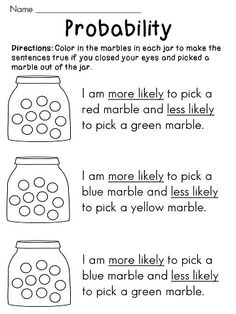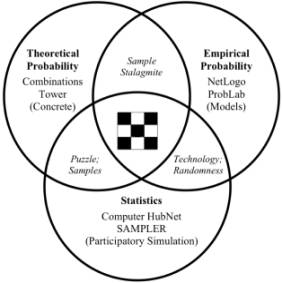Experimental Probability Worksheets
Are you an educator or a parent seeking high-quality worksheets to reinforce the concept of experimental probability? Look no further! In our collection of worksheets, we provide a wide range of exercises that focus on this important mathematical concept. Whether you are teaching probability to middle school students or looking for engaging practice activities for your child, our worksheets offer clear instructions and thought-provoking questions that will help learners grasp the concept of experimental probability with ease.
Table of Images 👆
More Other Worksheets
Kindergarten Worksheet My RoomSpanish Verb Worksheets
Cooking Vocabulary Worksheet
DNA Code Worksheet
Meiosis Worksheet Answer Key
Art Handouts and Worksheets
7 Elements of Art Worksheets
All Amendment Worksheet
Symmetry Art Worksheets
Daily Meal Planning Worksheet
What is experimental probability?
Experimental probability refers to the likelihood of an event occurring based on data collected from conducting an experiment or observation. It is calculated by dividing the number of successful outcomes by the total number of outcomes observed. This form of probability is empirical and is used when traditional theoretical probability cannot be determined with exact precision.
How is experimental probability calculated?
Experimental probability is calculated by dividing the number of favorable outcomes by the total number of outcomes in a specific experiment or trial. For example, if you roll a six-sided die 30 times and get a 6 ten times, the experimental probability of rolling a 6 would be 10 (favorable outcomes) divided by 30 (total outcomes), which equals 1/3 or approximately 0.33.
How is experimental probability different from theoretical probability?
Experimental probability is based on actual outcomes obtained through experiments or observations, while theoretical probability is calculated based on mathematical principles and assumptions. Experimental probability relies on empirical data and real-life events to determine the likelihood of outcomes, while theoretical probability uses formulas and probabilities based on the assumption of equally likely outcomes. Essentially, experimental probability is derived from observations of events occurring in the real world, while theoretical probability is calculated based on mathematical analysis of possible outcomes.
What is the purpose of conducting experiments to determine probability?
The purpose of conducting experiments to determine probability is to quantify the likelihood of different outcomes occurring in a specific event or situation. By running experiments and collecting data, researchers can calculate the probability of certain events happening and use this information to make informed decisions, assess risks, and predict future outcomes. Probability experiments help in understanding the underlying patterns and randomness in various phenomena, which is crucial in fields such as mathematics, statistics, and science.
What types of events can be used to calculate experimental probability?
Some examples of events that can be used to calculate experimental probability include rolling a die and observing the number that lands face up, flipping a coin and recording whether it lands heads or tails, selecting a card from a deck and determining its suit or value, spinning a spinner and noting where the pointer stops, or drawing a colored marble from a bag and noting its color. These events involve outcomes that can be observed and counted to calculate the likelihood of a specific outcome occurring based on experimental results.
Why is it important to conduct multiple trials when calculating experimental probability?
It is important to conduct multiple trials when calculating experimental probability to minimize the impact of random fluctuations or anomalies that may occur in a single trial. By conducting multiple trials, a more accurate estimate of the true probability of an event can be obtained, as it allows for patterns to emerge and outliers to be identified, resulting in a more reliable and representative measure of the likelihood of an event occurring.
How can experimental probability be affected by the size of the trial?
The size of the trial can affect experimental probability by impacting the accuracy and reliability of the results. In smaller trials, the experimental probability may not accurately represent the true probability of an event due to random variability. However, as the sample size increases, the experimental probability tends to converge towards the true probability, leading to more reliable conclusions. Additionally, larger trials reduce the impact of outliers and chance fluctuations on the results, providing a more stable estimate of the probability of an event occurring.
What are some limitations of using experimental probability to estimate real-world probabilities?
Some limitations of using experimental probability to estimate real-world probabilities include the possibility of bias in the sample data, the influence of random variability which may not accurately reflect true probabilities, the need for large sample sizes to produce reliable estimates, and the inability to account for all possible factors that may impact the outcome. Additionally, experimental probability relies on past outcomes to predict future events and may not be applicable in scenarios where outcomes are dependent on changing conditions or unknown variables.
How can experimental probability be used to make predictions or decisions?
Experimental probability can be used to make predictions or decisions by providing a basis for estimating the likelihood of an event occurring based on past trials or experiments. By conducting multiple trials and recording the outcomes, one can calculate the experimental probability of an event happening and use this information to inform decisions or predictions. This can be particularly useful in situations where exact probabilities are not known or where historical data can be utilized to guide future actions.
How can the results of experimental probability be compared to theoretical probability?
The results of experimental probability can be compared to theoretical probability by calculating the ratio of the number of favorable outcomes to the total number of outcomes in both scenarios. Experimental probability is based on actual outcomes from conducting experiments or observations, while theoretical probability is derived from mathematical calculations and assumptions. By comparing the results of experimental probability with theoretical probability, one can determine the degree to which real-world outcomes align with predictions based on probability theory.
Have something to share?
Who is Worksheeto?
At Worksheeto, we are committed to delivering an extensive and varied portfolio of superior quality worksheets, designed to address the educational demands of students, educators, and parents.
































Comments